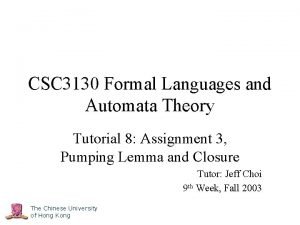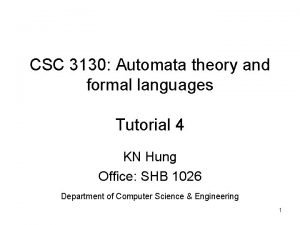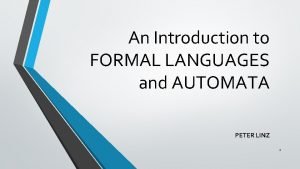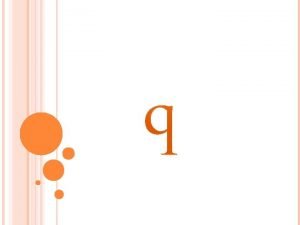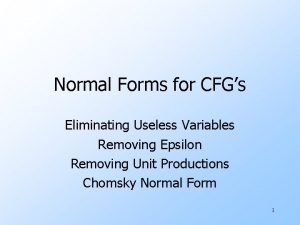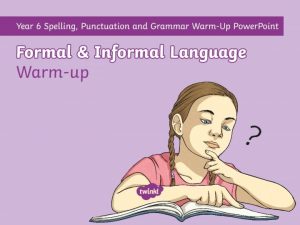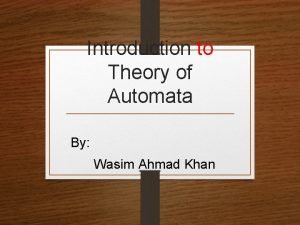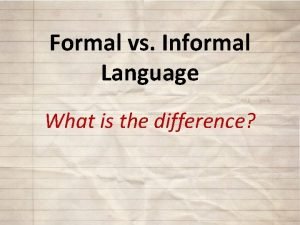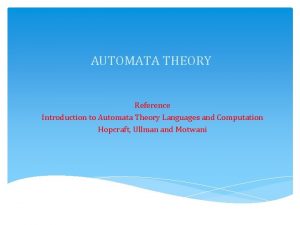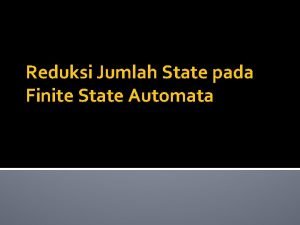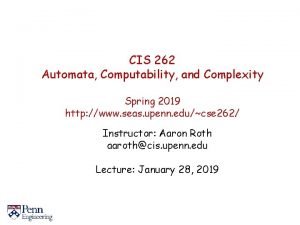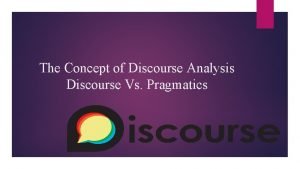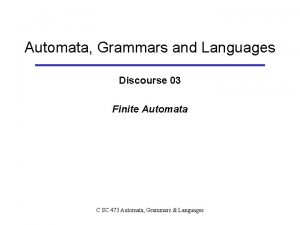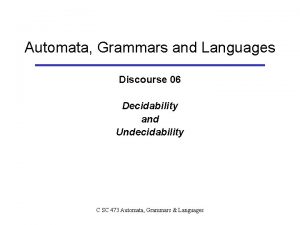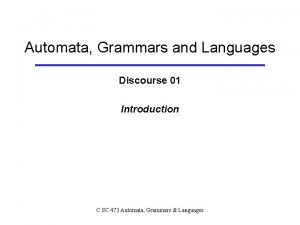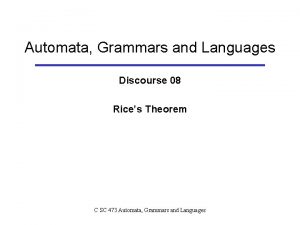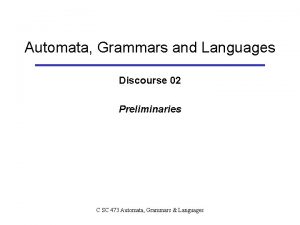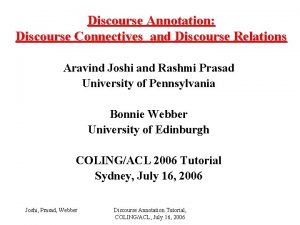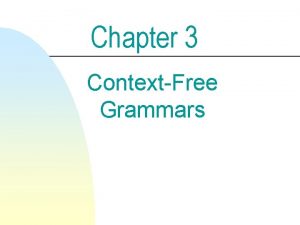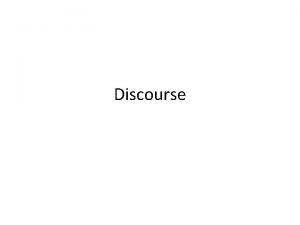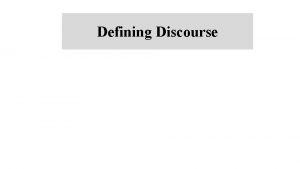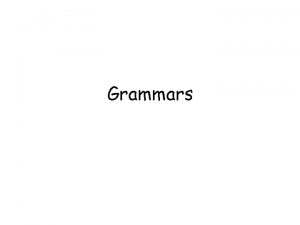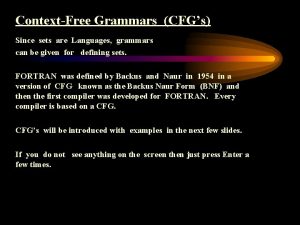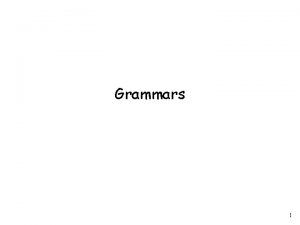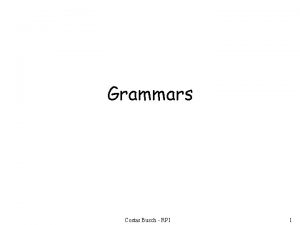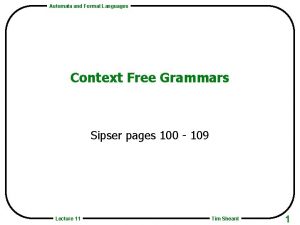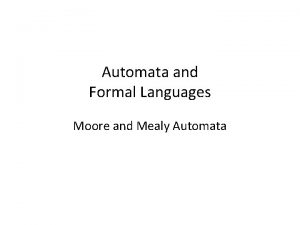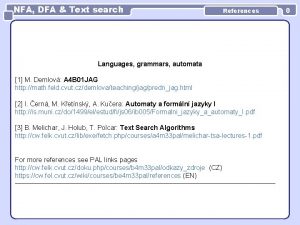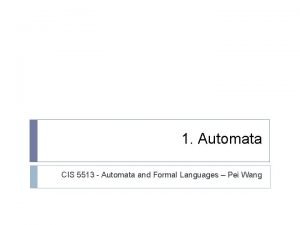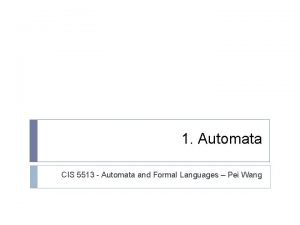Automata Grammars and Languages Discourse 07 Reduction C
























- Slides: 24

Automata, Grammars and Languages Discourse 07 Reduction C SC 473 Automata, Grammars and Languages

Reduction of One Problem to Another • Often want to solve a new problem P similar to a problem Q that has already been solved. • One way of solving P is to transform each instance of P into an instance of the known problem Q, then solve the Q instance, and then use it to obtain a solution to the P instance. • The solution to P uses the solution to Q as a “subroutine”. • We often write P Q for “P is reducible to Q” • Ex: Squaring Multiplication: • Ex: Multiplication Squaring: • Ex: DFA Equivalence DFA Emptiness C SC 473 Automata, Grammars and Languages 2

Using Reduction to Prove “Difficulty” • If P Q and P is known to be “hard to solve”, then Q must be hard to solve too. • For example¶, if P Q and P is undecidable, then Q must also be undecidable. For if Q is decidable, we can use the reduction P Q to construct a decider for P; contradiction. • Ex: We will show by reduction that the problem is reducible to the problem • The undecidability of will imply the undecidability of ________________ ¶Here stands for many-one or mapping reduction denoted m. It will be defined precisely later. C SC 473 Automata, Grammars and Languages 3

Undecidability via Reductions: Halting • HALTING PROBLEM • ACCEPTANCE (MEMBERSHIP) PROBLEM • Thm 5. 1: is undecidable. Pf: We show that so that if we had a decider for we could build a decider for This contradicts the undecidability of , and so must be undecidable. Assume, contrary to what is to be proved, that has a decider R. Following is a visual proof that is reducible to : C SC 473 Automata, Grammars and Languages 4

Undecidability via Reductions (cont. ) Consider a “compiler” (algorithm) C that given M constructs a new TM C( M ) as follows: acc rej n loop Reduction: use this and R to build a decider for acc rej So S is a decider for C SC 473 Automata, Grammars and Languages Contradiction theorem. � 5

Undecidability: Empty Tape Acceptance • Thm: The EMPTY-TAPE-ACCEPTANCE problem is undecidable: Pf: We will show that. Consider a “compiler” C that given M, w constructs TM C( M, w ): acc rej In fact: C SC 473 Automata, Grammars and Languages 6

Empty Tape Acceptance (cont’d) • Reduction: assume a decider R for construct a decider from it for. . We acc rej • E is a decider for C SC 473 Automata, Grammars and Languages rej . Contradiction. � 7

Undecidability: Empty Set Acceptance • Thm: The EMPTY-SET-ACCEPTANCE problem is undecidable: Pf: We will show that. We reduce the complement of to this problem. Consider a “compiler” C that given M, w constructs TM C( M, w ): C SC 473 Automata, Grammars and Languages acc rej 8

Empty Set Acceptance (cont’d) • Reduction: assume a decider R for construct a decider from it for. . We acc rej • E is a decider for C SC 473 Automata, Grammars and Languages rej . Contradiction theorem � 9

Undecidability: Regular Set Acceptance • Thm 5. 3: The REGULAR-SET-ACCEPTANCE problem is undecidable: Pf: We will show that Consider a “compiler” C that given M, w constructs TM C( M, w ): (2) acc (1) acc rej C SC 473 Automata, Grammars and Languages 10

Regular Set Acceptance (cont’d) • Reduction: assume a decider R for construct a decider from it for. . We acc rej • E is a decider for C SC 473 Automata, Grammars and Languages rej . Contradiction theorem � 11

Mapping Reduction: Motivation x Y N • Halting Problem • Empty-Tape Acceptance Problem • Empty-Set Acceptance Problem • Regular-Set Acceptance Problem C SC 473 Automata, Grammars and Languages C is an algorithm in each case 12

TMs can Act as Recognizers or Transducers • Defn 5. 17: A function is a computable function† if a TM transducer M such that on every input w, M halts with f(w) on its tape. Such a TM is called an algorithm. Compare & contrast this definition with: • Defn 3. 6: A language is a decidable language if a TM recognizer M such that on every input w, if w L it halts with “accept” and if w L it halts with “reject”. Such a TM is called a decider. A recognizer can be viewed as a special case of a transducer that prints only a 1 or 0 n A language can be viewed as a special case of a function that returns a boolean value. ______________ n †Also called total computable function. “Total” means “defined for all arguments w”. C SC 473 Automata, Grammars and Languages 13

Function: Set : : Transducer: Recognizer Computable† f TM transducer M • ( w) M on w halts & prints M(w) • ( w) M(w) = f(w) M is called an algorithm Decidable L TM recognizer M • ( w) M on w halts & prints 0, 1 • ( w) M(w) = 1 w L M is called a decider ‡ Special case of Partial† Computable f TM transducer M • ( w) M on w halts f(w) defined • ( w) M(w) = f(w) M is called a procedure Special case of Sets (Languages) Special case of Functions Recognizable L TM recognizer M • ( w) M on w halts w L • ( w) M(w) = 1 w L M is called a recognizer Special case of C SC 473 Automata, Grammars and Languages 14

Mapping Reduction: Definition x Y N • All have the same pattern n n f must be a computable function The “compiler” must be an algorithm • Defn 5. 20: Language is mapping reducible to language iff a computable function such that Function f is called the reduction of to. C SC 473 Automata, Grammars and Languages 15

Mapping Reduction: Definition (cont’d) x Y N • Picture: equivalent to C SC 473 Automata, Grammars and Languages 16

Reduction (cont. ) • Thms 5. 22, 5. 23, 5. 28, 5. 29: Let . Then decidable hardness undecidable recognizable non-recognizable n n easiness If you want to show a problem P is easier than problem Q then reduce P to Q P: ? Q u If you want to show a problem P is harder than problem Q then reduce Q to P u Q: C SC 473 Automata, Grammars and Languages ? P 17

Reductions • Thm: • Ex: • Reduction: major method for showing unsolvability or nonrecognizability: n n Goal: to show is not recognizable [not decidable] Known: is not recognizable [not decidable] Strategy: reduce to Method: build computable “translator” f to accept assuming we have a recognizer [decider] for yes w f C SC 473 Automata, Grammars and Languages 18

Undecidable via Reductions • Thm: The NONEMPTY-SET-ACCEPTANCE problem is TMrecognizable but not decidable: Pf: It is easy to see that So decidable. An acceptor for encode C SC 473 Automata, Grammars and Languages since cannot be is the following nondeterministic TM yes 19

Non-Recognizable via Reductions • Thm: The EQUIVALENCE problem is not recognizable: Pf: We show that is not recognizable by showing that (which means that ). The reducing function generates a pair of TMs with the following behaviors: rej acc C SC 473 Automata, Grammars and Languages 20

Non-recognizable via m (cont’d) • Reduction: assume a decider for We construct a decider from it for. . acc rej • S is a decider for implies that recognizable � C SC 473 Automata, Grammars and Languages . So and so rej This cannot be 21

Non-Recognizable via Reductions (cont’d) • Exercise: The FINITE-SET-ACCEPTANCE problem is not TM-recognizable: Proof: Show that • Exercise: The INFINITE-SET-ACCEPTANCE problem is not TM-recognizable: Proof: Show that C SC 473 Automata, Grammars and Languages 22

Equivalence and Completeness • Definition: Let C be a class of sets. A set A is mapping reduction complete ( -complete ) in C iff n n u Remark: “A is complete” says A is a “hardest problem in C” A is mapping equivalent to B iff • Fact: all complete sets in C are mapping equivalent • Exercise: C SC 473 Automata, Grammars and Languages 23

Completeness • Theorem: is complete in the class TM of Turingrecognizable sets. Proof: is accepted by U, so is in TM. To show completeness, let B be any Turing-recognizable set in TM. Then a TM such that. Define the computable function Then Since B was chosen arbitrarily in TM the result follows � • Exercise: Show the Halting Prob. is complete in TM C SC 473 Automata, Grammars and Languages 24
 Regular grammars generate regular languages.
Regular grammars generate regular languages. Discourse analysis in linguistics
Discourse analysis in linguistics Csci3130
Csci3130 Automata theory tutorial
Automata theory tutorial Cyk algorithm
Cyk algorithm Gtg stands for in automata
Gtg stands for in automata Csci 3130
Csci 3130 Formal language
Formal language Unrestricted grammars
Unrestricted grammars Handling questions in context-free grammars
Handling questions in context-free grammars Removal of epsilon productions
Removal of epsilon productions Types of grammar
Types of grammar Half reaction at anode
Half reaction at anode What is formal language
What is formal language Valid and invalid alphabets
Valid and invalid alphabets Qualities of formal language
Qualities of formal language The central concepts of automata theory
The central concepts of automata theory Reduksi jumlah state pada dfa
Reduksi jumlah state pada dfa Automata, computability, and complexity
Automata, computability, and complexity Difference between text and discourse
Difference between text and discourse What is discourse analysis
What is discourse analysis Discourse analysis vs pragmatics
Discourse analysis vs pragmatics What is ideology
What is ideology Planned and unplanned discourse
Planned and unplanned discourse What is discourse analysis
What is discourse analysis



